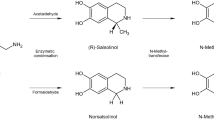Abstract
Background and purpose
The objective of this study is to investigate the relationship between excitatory substances by testing the urine in children with Tourette syndrome (TS).
Methods
We performed a control study involving 44 patients with TS and 44 normal children by investigating the children’s daily eating habits. We used the gas chromatograph–mass spectrometer and liquid chromatograph–mass spectrometer from Agilent. Substances for detection included 197 excitatory substances prohibited by the International Olympic Committee and other substances with similar chemical structures or biological functions for urine samples.
Results
Forty-four patients who did not take any drugs in the past 2 weeks enrolled in the study. The positive rate in the experiment group was three cases, while it was negative in the control group. The level of 1-testosterone increased in one extremely severe TS patient who ate large amounts of puffed food and drank an average of 350 ml of cola per day. Cathine and other substances with similar chemical constitution or similar biological effects increased in one severe TS patient who ate bags of instant noodles daily, according to the high score of the Yale Global Tic Severity Scale.
Conclusion
An increase in ephedrine type, testosterone, and stimulants may be related to the pathogenesis of TS. Unhealthy food possibly causes TS. The relationship between excitatory substances and TS needs to be explored with the goal of providing more information on diagnosing and treating TS.
Similar content being viewed by others
References
Scahill L, Williams S, Schwab-Stone M, Applegate J, Leckman JF (2006) Disruptive behavior problems in a community sample of children with tic disorders. Adv Neurol 99:184–190
Mason A, Banerjee S, Eapen V, Zeitlin H, Robertson MM (1998) The prevalence of Tourette syndrome in a mainstream school population. Dev Med Child Neurol 40:292–296
Kano Y, Ohta M, Nagai Y, Pauls DL, Leckman JF (2001) A family study of Tourette syndrome in Japan. Am J Med Genet 105:414–421
Hasstedt SJ, Leppert M, Filloux F (1995) Intermediate inheritance of Tourette syndrome, assuming assortative mating. Am J Hum Genet 57:682–689
Seuchter SA, Hebebrand J (2000) Complex segregation analysis of families ascertained through Gilles de la Tourette syndrome. Genet Epidemiol 18:33–47
Roessner V, Robatzek M, Knapp G, Banaschewski T, Rothenberger A (2006) First-onset tics in patients with attention-deficit-hyperactivity disorder: impact of stimulants. Dev Med Child Neurol 48:616–621
Kurlan R (2003) Tourette’s syndrome: are stimulants safe? Curr Neurol Neurosci Rep 3:285–288
Lowe TL, Cohen DJ, Detlor J, Kremnitzer MW, Shaywitz BA (1982) Stimulant medications precipitate Tourette’s syndrome. JAMA 247:1729–1731
Comings DE (1990) Blood serotonin and tryptophan in Tourette syndrome. Am J Med Genet 36:418–430
Keen-Kim D, Freimer NB (2006) Genetics and epidemiology of Tourette syndrome. J Child Neurol 21:665–671
Kurlan R (1992) The pathogenesis of Tourette’s syndrome: a possible role for hormonal and excitatory neurotransmitter influences in brain development. Arch Neurol 49:874–876
Kurlan R (1989) Tourette’s syndrome: current concepts. Neurol 39:1625–1630
Peterson BS, Zhang H, Anderson GM, Leckman JF (1998) Double-blind, placebo-controlled, crossover trial of an antiandrogen in the treatment of Tourette’s syndrome. J Clin Psychopharmacol 18:324–331
Jin R, Zheng RY, Huang WW, Xu HQ, Shao B, Chen H, Feng L (2005) Epidemiological survey of Tourette syndrome in children and adolescents in Wenzhou of P.R. China. Eur J Epidemiol 20:925–927
American Psychiatric Association (2000) Diagnostic and Statistical Manual of Mental Disorders, 4th edn (DSM-IV-TR). American Psychiatric Association, Washington, DC, pp 111–114
Leckman JF, Riddle MA, Hardin MT (1989) The Yale Global Tic Severity Scale: initial testing of clinician-rated of tic severity. J Am Acad Child Adolesc Psychiatry 28:566–573
Sharma AN, Olmedo R (2003) Ephedrine-induced Tourette syndrome. J Toxicol Clin Toxico 41:668–669
Goran MI, Ball GD, Cruz ML (2003) Obesity and risk of type 2 diabetes and cardiovascular disease in children and adolescents. J Clin Endocrinol Metab 88:1417–1427
Tang HL, Shna JP, Gong YF (2003) Detection of serum testosterone, estradiol and progesterone in children with Tourette syndrome. J Appl Clin Pediatr 18:719–720, Chinese
Acknowledgments
We thank all children who participated in this study and all clinicians involved in collecting the samples. We thank the technicians in the stimulant test laboratory for the 2008 Beijing Olympics.
Author information
Authors and Affiliations
Corresponding authors
Additional information
Ying Wang is the co-first author.
Rights and permissions
About this article
Cite this article
Zou, LP., Wang, Y., Zhang, LP. et al. Tourette syndrome and excitatory substances: is there a connection?. Childs Nerv Syst 27, 793–802 (2011). https://doi.org/10.1007/s00381-010-1318-4
Received:
Accepted:
Published:
Issue Date:
DOI: https://doi.org/10.1007/s00381-010-1318-4




